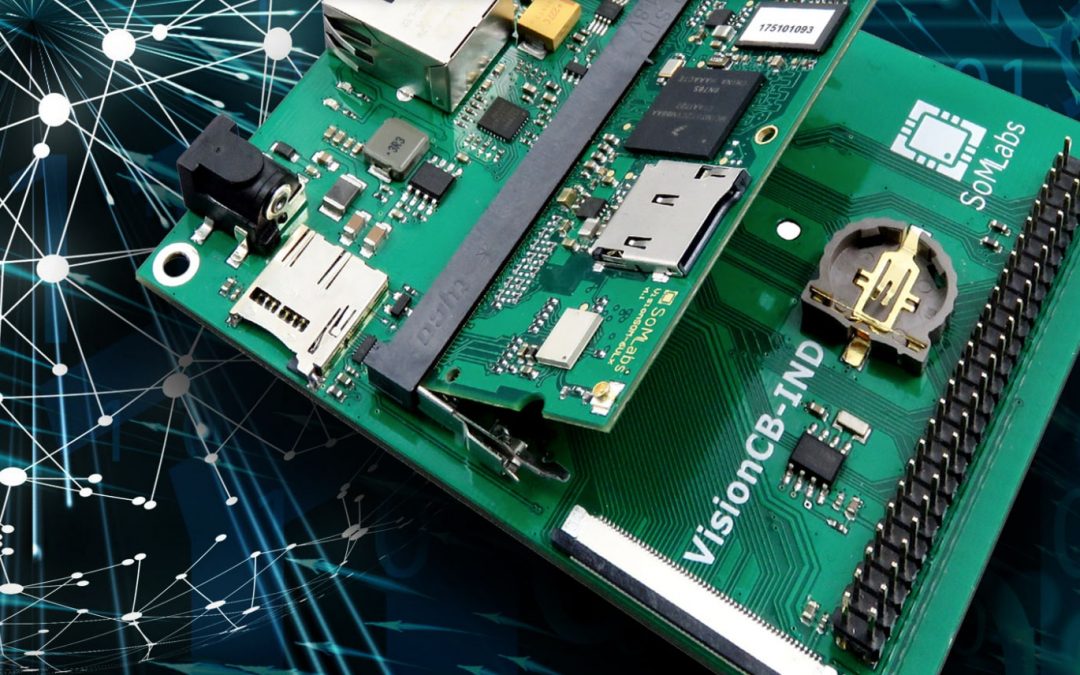Essentially, an electronic system designed using embedded modules as the basic “components” will consist of a Carrier Board, a System-on-Module (SoM) and one or more peripheral boards, for example a touch display module or a camera vision module.
The SoM integrates multiple functions by incorporating a number of electronic components into a single board. The SoM module can then be installed in a carrier board, providing connectors, power and access to the other components.
A system designed using embedded modules can perform just about any function. Major manufacturers have created SoM products supporting applications ranging from IoT data logging to high-speed video connectivity.
Designing with embedded modules offers many benefits over designing from scratch:
Reduced design time. Using off-the-shelf modules cuts out a large amount of design time, reducing the risk of product introduction failure as commercially-sourced embedded modules are qualified and fully tested.
Reduced production time. The time required to manufacture and test a complex CPU subsystem is completely avoided.
Reduced time-to-market. The much-reduced time spent on design plus the time-savings in production and test result in a much faster time-to-market, making it quicker to become profitable.
Cost reduction. The engineering costs associated with manufacturing can be almost completely eliminated.
Regular product updates. Product updates can be carried out by swapping out modules, extending the lifetime of a product by updating with the newest technology.
End-of-Life (EoL) pushed back. Swapping modules will also minimise the risk of the finished product becoming obsolete due to for example a memory or CPU component becoming unavailable.
Some examples of embedded modules
System-on-Modules. The SoM is perhaps the most important embedded module that a system will require. A typical SoM incorporates at least one microprocessor or digital signal processor (DSP). Memory blocks will include a selection of ROM, RAM, EEPROM and/or flash memory.
Timing devices include industry-standard communication interfaces such as USB, FireWire, Ethernet, USART, SPI, I²C. Peripherals will include counter-timers, real-time timers and analogue interfaces such as analogue-to-digital converters and digital-to-analogue converters.
Arm-Cortex based SoMs dominate the System-on-Module world. A typical example is the AI-focused SoMLabs VisionSOM-V2L from Inelco Hunter. TheSoM incorporates an ARM Cortex-A55 dual core CPU and an ARM Cortex-M33 CPU with a built-in AI accelerator. Specifications include 4GB DDR4, up to 32GB eMMC flash and optional QSPI flash, built-in video codec and dual CAN-FD interfaces.
Touch Displays. One of the most time-consuming tasks when designing an integrated industrial solution is to get the display and the chosen processor working perfectly together. A fully-optimised, ready-to-run embedded touch display modules will offer an optimal easy-to-use solution.
A good example available on the market is the 10.1 inch PCAP Touch Screen Kit, developed by Inelco Hunter utilising a Raspberry Pi. This cost-effective, pre-assembled display kit offers time savings by speeding up installation and cutting development time. The screen comes pre-assembled and provides a resolution up to WXGA.
Another example is applications where the ultimate in power and display response speed is needed.The Inelco Powertip MPU range of displays utilises NXP or Rockchip Quad Core processors, providing what might be called blindingly fast response times and the ultimate in smooth 2D/3D graphics.
Embedded Vision Modules. High-performance, industrial-grade camera solutions will accelerate time-to-market for embedded vision projects. Traditional applications include surveillance cameras, security systems and industrial automation, but the rapid developments of AI is opening up many new applications including for example robotics and drones.
Embedded vision enables robots and drones to perceive and interact with their surroundings. They can navigate environments, detect obstacles, recognise objects, and perform complex tasks with precision.
The control of autonomous vehicles is another fast-growing application and embedded vision plays a crucial role by providing real-time visual perception. It enables object detection, lane tracking, pedestrian recognition, and traffic sign interpretation, enhancing safety and navigation.
Precision, speed and the ability to work dependably in low-light conditions is absolutely essential. A good example of a high-performance embedded vision module is the TechNexion range of embedded vision camera modules. They incorporate Global Shutter or Rolling Shutter Sensors up to 13MP, capturing high-speed dynamic targets clearly with ultra-short exposure times even in low-light conditions.
Carrier Boards. Flexibility is key with carrier boards. As with SoMs, many standard specifications and combinations of functions are available. Carrier boards can also be used to evaluate a proposed SoM by providing full access to the SoM interface.
In addition, manufacturers like SoMLabs offer open-source hardware so that designers can easily develop their custom carrier boards based on their specific requirements.
Configuration support
Understanding and selecting the most appropriate embedded module configuration can seem daunting at first. Product understanding and support are not just important but paramount to Inelco Hunter’s philosophy, driving added-value support at the very core for the past three decades.

